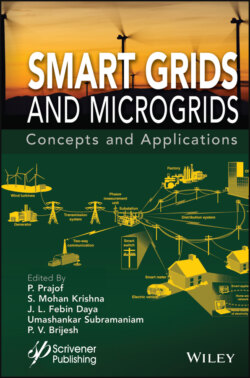Читать книгу Smart Grids and Micro-Grids - Umashankar Subramaniam - Страница 42
2.5.1 DC-DC Bidirectional Converter Interfacing DC-Microgrid
ОглавлениеIn order to exchange power with the dc microgrid or dc link of the microgrid circuit from ESS, a DC-DC bidirectional converter is required. Depending on the voltage of the microgrid and battery, a different configuration of DC-DC could be used. As an example, Figure 2.2 shows a bidirectional boost converter interfacing battery to the DC system or DC-link of the DC-AC converter. Based on the requirement of the microgrid, the following condition could arise:
Figure 2.2 Boost converter interfacing battery to dc microgrid.
1 a. ESS (Energy Storage Systems) may be required to discharge if the energy management system (EMS) of the microgrid needs power from the ESS
2 b. If ESS is discharged or there is excess power from the other distributed energy sources, the ESS is supposed to be charged.
3 c. In case the dc microgrid voltage deviates from its reference value and other ESS in the system fails to maintain the microgrid voltage owing to a low state of charge (SOC), the ESS with a considerable amount of capacity left has to control the microgrid voltage.
To fulfill the above objective/role of the ESS, the converter controller should have the provision of working in all the modes as dictated by EMS. One typical configuration of such a controller is shown in Figure 2.3. The signal Batt – charge, IB(cha, ref), IB(disc, ref), Vdc-ctrl are provided by the EMS depending on the requirement of the microgrid. When battery has to be discharged, command Batt – charge = 0, Vdc-ctrl = 0 and reference battery discharge reference current (IB(cha, ref)) is received from EMS. The current loop is activated where reference current is compared to battery current to produce error signal which is sent to PI controller to produce PWM. Since the current has to be supplied by the ESS, the bottom switch (SL) has to be modulated and the gating signal of the top switch (SH) has to be disabled. This is achieved by multiplying the PWM signal with the Batt – charge command to ensures that the proper gating signal is sent to the converter. If Batt – charge = 1, Vdc-ctrl = 0 and reference battery charge reference current (IB(cha, ref)) is received from EMS, it implies that battery has to be charged. This requires that the top switch (SH) has to be modulated and the bottom diode (DL) would be working. The Batt – charge = 1, multiplied with PWM produces the top switch gating signal (GH) for the top switch and turns-off the bottom gating signal (GL = 0).
Figure 2.3 Typical configuration of the controller.
The signal Vdc-ctrl = 1 from EMS implies that the battery is required to maintain the dc voltage of the microgrid. There are two loops in control to have the fast dynamic response of the system. The outer voltage loop compares the reference voltage to the voltage of the microgrid. The error signal is passed through the PI controller to produce the reference current. This reference current is compared with the inductor current to generate an error, which is fed to PI to produce a duty cycle. When the dc-microgrid voltage (VDC) is lower than the reference microgrid voltage (VDC(ref)), the comparator produces a positive error, which results in an increase in the reference inductor current (IL(ref))) driving more current to microgrid and thereby increasing the dc voltage of the microgrid. Similarly, when the dc-microgrid voltage (VDC) is higher than the reference microgrid voltage (VDC(ref)), the voltage comparator produces a negative error, which results in decrease in reference inductor current (IL(ref)). This results in decrease in the current supplied by the battery-converter system, thereby resulting in decrease in the dc-microgrid voltage. The PWM module produces the gating signal for the switches. The modeling of converter and design of the control loop under different modes is discussed in the next section.
